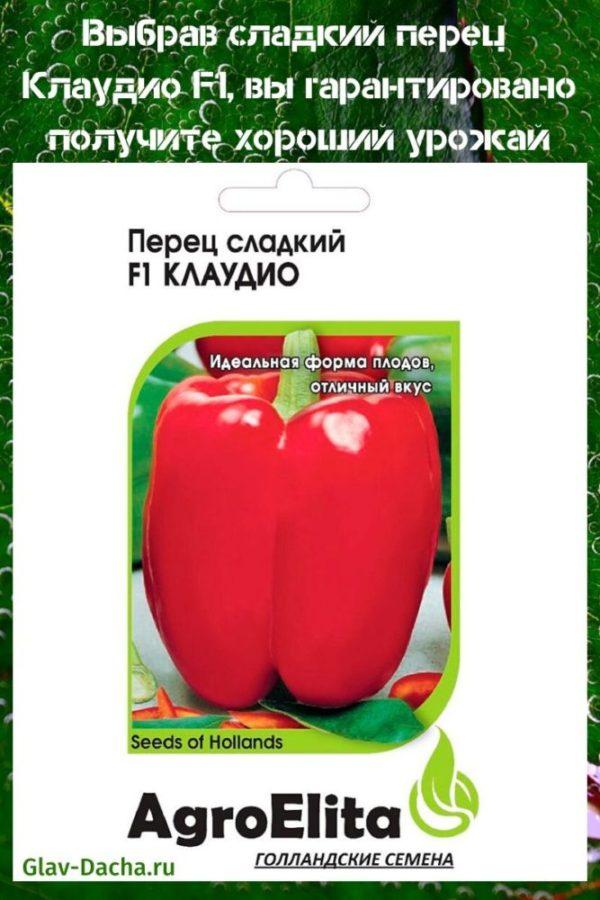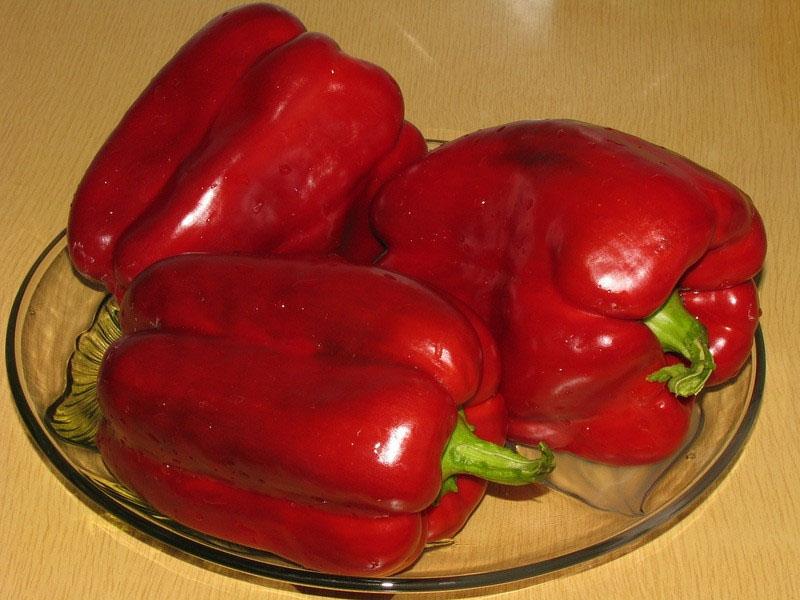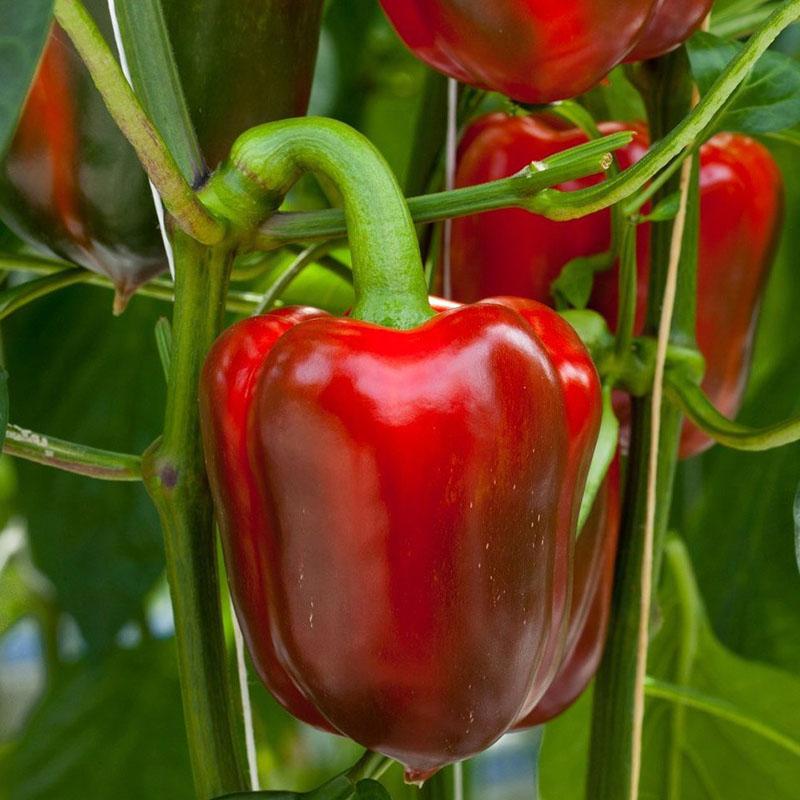Choosing Claudio F1 sweet peppers is guaranteed to get a good harvest
 Among amateur gardeners and professional farmers, the Dutch seed line is very popular. Pepper Claudio F1 is the representative of this group. Its selection was carried out by the Nunhems company, one of the structural divisions of the famous German concern Bayer. The quality of the seeds directly from this producer is always very high. Before going on sale, they are disinfected and treated with a special compound against various diseases. Therefore, the seeds do not require pre-sowing preparation.
Among amateur gardeners and professional farmers, the Dutch seed line is very popular. Pepper Claudio F1 is the representative of this group. Its selection was carried out by the Nunhems company, one of the structural divisions of the famous German concern Bayer. The quality of the seeds directly from this producer is always very high. Before going on sale, they are disinfected and treated with a special compound against various diseases. Therefore, the seeds do not require pre-sowing preparation.
Description of the Claudio sweet pepper

Botanical characteristics of the plant:
- hybrid variety, characterized by early ripening of fruits;
- grown in greenhouses, under light shelters and outdoors;
- the growing season does not exceed 80 days;
- bushes are erect, with a lot of leaves;
- these hybrids are characterized by high stress resistance, as well as good tolerance to ultraviolet rays;
- resistance to common viral diseases.

Description of the fruit of the sweet pepper Claudio F1:
- all peppers are elongated cuboid, with four distinct chambers;
- the average weight of the fruits is about 200 g, they are juicy and tasty, the pulp thickness is more than 10 mm;
- the usual size of the fruit is 8 cm x 16 cm, on one bush it can grow up to 12 pieces of the same size, shape and color.
With proper storage organization, the fruits do not lose their beneficial qualities for a long time.
Peppers collected in technical ripeness are stored for about two months. But if they managed to blush, they are removed from the bushes and used immediately, in salads and blanks.
Pepper Claudio f1: growing a versatile hybrid
 A culture like bell pepper requires a lot of sun and heat to develop. And this is clearly not enough in almost the entire territory of the country. Therefore, gardeners, in order to obtain guaranteed yields, prefer to grow plants under shelters or in greenhouses.
A culture like bell pepper requires a lot of sun and heat to develop. And this is clearly not enough in almost the entire territory of the country. Therefore, gardeners, in order to obtain guaranteed yields, prefer to grow plants under shelters or in greenhouses.
If Claudio F1 pepper seeds are purchased from another company and have not been pre-treated, you can do it yourself before soaking. In this case, seedlings will be earlier and more friendly.
Preliminary soil preparation is required:
- A plot with neutral fertile soils, the acidity index of which (pH) is 7, is allocated for the beds with pepper.
- Perform deep digging of soil with simultaneous removal of roots weeds.
- Fertilizers are applied, lime if necessary.
Productive Claudio F1 hybrids are grown by seedling method. For this, containers are prepared, ordinary cups or peat, boxes for sowing seeds.
Sowing seeds
 The seeds are planted in the soil at the end of February. But first they are placed in warm water, the temperature of which is about 50 ° C. After the seeds are swollen, they are wrapped in a slightly damp cloth. Can be additionally wrapped in thin cellophane. Put away in a warm place and leave for 3 days. After such stimulation, the seeds will hatch especially quickly.
The seeds are planted in the soil at the end of February. But first they are placed in warm water, the temperature of which is about 50 ° C. After the seeds are swollen, they are wrapped in a slightly damp cloth. Can be additionally wrapped in thin cellophane. Put away in a warm place and leave for 3 days. After such stimulation, the seeds will hatch especially quickly.
For seedlings, a soil mixture is prepared, consisting of garden soil, humus and sand. In total, take one glass and, after adding 1 tablespoon of ash, mix well. The mixture is disinfected in the oven or microwave. When the soil has cooled, it is laid out in cups. When planting, seeds are buried in the ground by 2 cm. After watering, the containers are covered with plastic wrap or glass.
If you plant several seeds in one pot, then after their germination, you can leave the strongest and most viable one.
Seedling care
 When growing pepper Claudio F1 for seedlings in boxes, slightly grown plants dive. But, compared to other vegetable crops, peppers do not tolerate transplanting well, so it is better to sow seeds in separate peat containers.
When growing pepper Claudio F1 for seedlings in boxes, slightly grown plants dive. But, compared to other vegetable crops, peppers do not tolerate transplanting well, so it is better to sow seeds in separate peat containers.
For further growth, delicate peppers will need to create special conditions.:
- regular ventilation of the room;
- lighting for 12 hours;
- moderate soil moisture;
- watering with warm, settled water;
- the temperature during the daytime should be about 26 ° C;
- temperature at night - not lower than 12 ° С.
 To maintain adequate moisture, plants are regularly sprayed with warm water. Peppers cannot stand cold water, which makes them stressful. Due to watering or spraying with chilled water, they lag behind and can become sick.
To maintain adequate moisture, plants are regularly sprayed with warm water. Peppers cannot stand cold water, which makes them stressful. Due to watering or spraying with chilled water, they lag behind and can become sick.
As soon as the plants have a second true leaf, they are fed with liquid fertilizers containing nitrogen, phosphorus, potassium and other trace elements. The second time is fertilized only after two weeks.
Planting peppers in open ground or greenhouse
 When the first buds begin to appear in the seedlings, the plants are planted in a permanent place. It is advisable to do this at the end of May, at which time warm weather finally sets in. The beds for peppers are prepared in advance.
When the first buds begin to appear in the seedlings, the plants are planted in a permanent place. It is advisable to do this at the end of May, at which time warm weather finally sets in. The beds for peppers are prepared in advance.
The best predecessors for the Claudio F1 hybrid pepper are pumpkin, onions, zucchini, carrots, cucumbers. It should not be planted after other nightshades.
 In late autumn, the soil is dug up and 50 g of superphosphate and potassium, as well as 5 kg of well-rotted compost, are added to 1 m². Immediately before planting seedlings, it is recommended to add 30 g of ammonium nitrate to the soil.
In late autumn, the soil is dug up and 50 g of superphosphate and potassium, as well as 5 kg of well-rotted compost, are added to 1 m². Immediately before planting seedlings, it is recommended to add 30 g of ammonium nitrate to the soil.
The landing pattern is as follows:
- in one row, plants are planted at a distance of at least 40 cm from each other;
- if several rows are assumed, a row spacing is left, 70 cm wide.
 Pour 1 tablespoon of a complex fertilizer into the wells for plants, which contains potassium, nitrogen and phosphorus. When planting, the root collar is not buried. Upon completion of planting work, the plants are watered abundantly.
Pour 1 tablespoon of a complex fertilizer into the wells for plants, which contains potassium, nitrogen and phosphorus. When planting, the root collar is not buried. Upon completion of planting work, the plants are watered abundantly.
Care features
 The cultivation of Claudio F1 sweet peppers is not a complicated or time-consuming process. Its high yield largely depends on compliance with the rules of agricultural technology. The correct formation of growing plants is very important. After the first forks appear on the peppers, it is necessary to remove all the lower leaves and buds. Peppers usually try to form two or three stems, leaving several stepsons.
The cultivation of Claudio F1 sweet peppers is not a complicated or time-consuming process. Its high yield largely depends on compliance with the rules of agricultural technology. The correct formation of growing plants is very important. After the first forks appear on the peppers, it is necessary to remove all the lower leaves and buds. Peppers usually try to form two or three stems, leaving several stepsons. 
There are some differences in agrotechnical methods in greenhouse conditions and in open beds. But there are also some important general recommendations.:
- The temperature at the beginning of the development of peppers should be within 22 ° C, and during the ripening period of the crop - 25-27 ° C.
- Lighting is a very important factor in the development of pepper hybrids. With its lack, the stems are stretched, and the fruits grow irregularly shaped.
- Before flowering, plants are fertilized with organic matter - rotted manure, and as soon as ovaries appear, fertilizers containing phosphorus are used. In the ripening phase, the hybrids need potash fertilizers.
- Claudio F1 peppers are watered manually or using a drip irrigation system.

Carrying out protective preventive treatments of plants will allow them to avoid damage by aphids, thrips, whiteflies, larvae May beetle... And also protects against diseases.